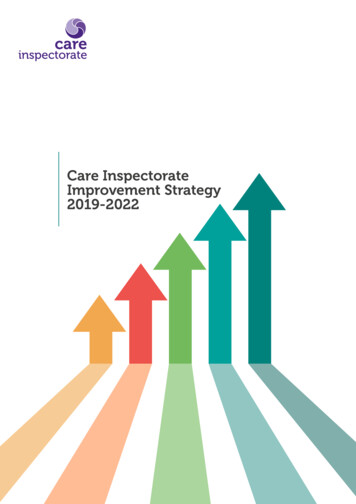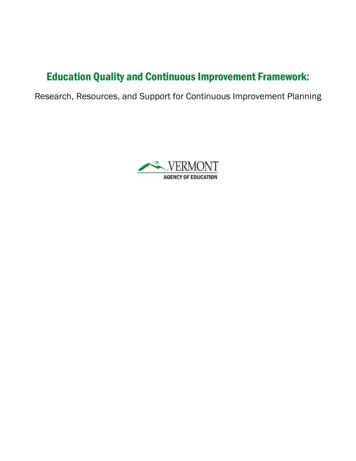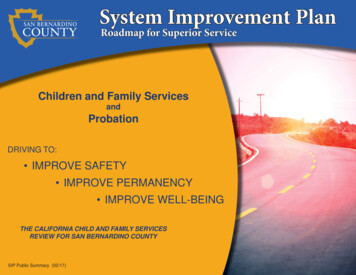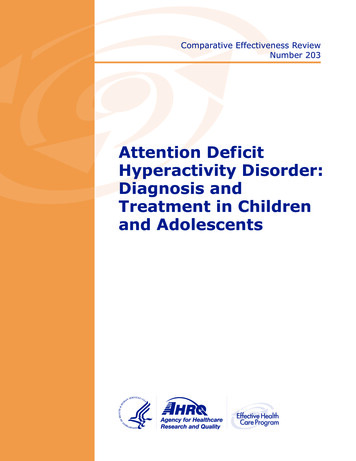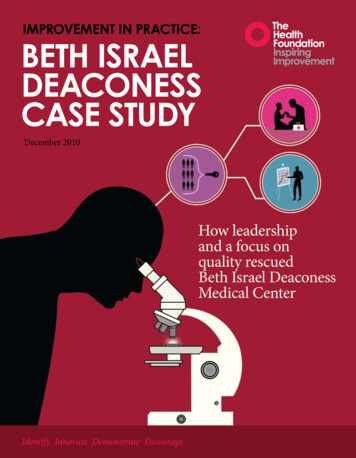
Transcription
Improvement in practice:Beth IsraelDeaconessCase StudyDecember 2010How leadershipand a focus onquality rescuedBeth Israel DeaconessMedical CenterIdentify Innovate Demonstrate Encourage
‘ his strategy was to create aburning platform.escape wasonly possible by making harddecisions and by doing thingsradically different’The Health Foundation case studiesOur case studies aim tocapture compelling stories aboutimprovement in practice. Writersspend time onsite interviewingteams and individuals and, wherepossible, patients affected by thechanges.The data used are publiclyavailable information or selfreported data provided by thecase study institution. Usingpractical examples from ourwork around the UK or othernational and international caseswe create a narrative on theenablers and barriers to effectiveimplementation.We hope they inspire and motivateothers and prompt furtherquestions and investigation.For more information about usand the work that we do, visitwww.health.org.ukThe inclusion of an organisationor health service in one of our casestudies should not be regardedas an overall endorsement of thatorganisation and its services. 2010 The Health FoundationImprovement in practice ispublished by the Health Foundation90 Long Acre, London WC2E 9RAAbout the AuthorDr Kamran Abbasi FRCPis a doctor and the author ofImprovement in practice:Beth Israel Deaconess case study.Following five years in hospitalmedicine, Kamran moved intomedical journalism and has beendeputy editor and acting editorof the BMJ (British MedicalJournal) and editor of the WorldHealth Organisation’s Bulletin, aninternational public health journal.Kamran has played a leading rolein online learning and knowledgesharing for health professionals.He created BMJ Learning, awebsite providing formal onlinelearning for doctors; has beenmedical director of Dr Foster Ltdand Chief Executive of OnMedicaLtd, a specialist company in onlinelearning technologies in this field.He is also an honorary seniorlecturer at Imperial College anda Patron of the South AsianHealth Foundation.Currently, Kamran is editor ofJournal of the Royal Society ofMedicine and editor of the newonline journal, JRSM Short Reports.He also writes for cricinfo.com,a highly rated cricket website,and is author of the popular cricketblog Pak Spin.
health foundation COMMENTARYFor many NHS leaders, there will be much that is familiar in the challengesfaced by Paul Levy. When he became CEO of Beth Israel Deaconess in 2002,the organisation faced financial crisis, deep seated problems with the qualityand safety of patient care, poor staff morale and fractious relationships,and all played out in the media spotlight.CommentaryEight years later, Levy acknowledgesthat he still has much to do andthat some of the journey has beenthrough stormy waters. But therecan be little doubt that with his leadershipthe organisation has salvaged its reputationand is now thriving in the unforgivingUS healthcare environment.There is much for established andaspiring leaders in the UK health sector toreflect on when they read this case study.Levy’s approach was an interesting mix ofchallenge and support. He did not shy awayfrom revealing the depth of the financial andreputational crisis the medical centre faced.Indeed, his strategy was to create a burningplatform where escape was only possible bymaking hard decisions and by doing thingsradically different.At the same time, he knew he could onlyachieve change by impassioning his staffwith a sense of common purpose. He choseto advocate an absolute commitment toproviding high quality care and to usingsystematic approaches to continuousquality improvement. When times havebeen hard, it has been Levy’s unrelentingfocus on quality and safety that has kept theorganisation moving forward. What makeshis approach stand out is his belief thattransparency is key to delivering highquality care. By being open with his staffand with the community that the medicalcentre serves, he has managed to build alevel of trust which is an essential elementof a culture of continuous improvement.Much of the learning from this case studyresonates with our understanding aboutimprovement and about leadership forimprovement. It isn’t easy territory andthere are few right answers. A delicatebalance of technical and interpersonal skillsis required. Success is about conveying acompelling vision that focuses on patientsand those who use health services. Peoplerespond positively when you engage withtheir core values and internal motivations.High quality data, and a willingness to beopen with the data, underpins success.These are not new messages but we all needreminding of their importance. And hereinlies the contribution that stories such asthis can make to our understanding ofhow to improve patient care. We hopeyou enjoy reading it and share it with yourcolleagues, and we look forward to hearingyour reflections. Beth Israel Deaconess case study 03
SUMMARY‘ Transparency is animportant tool in qualityimprovement, provided itis linked to accountability’CHALLENGE Progress to date A competitive healthcare environmentin Boston was the backdrop to amerger between two large hospitalswith differing cultures.Beth Israel Deaconess is now an importantplayer in Boston healthcare, and competeseffectively with other major healthcareorganisations.The merger was followed by a period ofuncertainty, staff cuts, and loss of patientconfidence, culminating in the threat offinancial collapse.Quality improvement is central to theorganisation’s approach. A culture oftransparency and accountability has beenestablished. Challenges remain, but pastones have been overcome by adheringto these organisational values.Financial rescue was achieved, but howwould the newly-merged and dysfunctionalBeth Israel Deaconess Medical Centerbecome valued by patients, staff,and referrers?Strategies The recovery plan was underpinned bysound leadership values that prioritisedtransparency and accountability, with asharp focus on quality improvement forbetter patient outcomes.Agents of change Chief executive and leadership team,operational plans, and the publicationof hospital performance data.04 Improvement in practiceLEARNING POINTS Sound leadership principles and a focus onquality can galvanise a troubled institution,restore patient satisfaction and improvefinancial performance.Transparency is an important tool inquality improvement, provided it is linkedto accountability.Data can be used meaningfully to improvequality provided that clinicians feel a sense ofownership in the development of the measures.All staff can be engaged with the financialgoals of a healthcare institution and participatein setting operational plans.
In January 2002, Paul Levy was appointed chiefexecutive of Beth Israel Deaconess MedicalCenter. The hospital was created in 1996 throughthe merger of Beth Israel Hospital and DeaconessHospital and had been a troubled institutionfrom the outset. By 2002, the hospital was facingfinancial meltdown.Levy was new to healthcare and the Beth IsraelDeaconess staff didn’t quite know what to expect.It was a time for strong leadership and Levyhad to quickly convert people to his cause orthe hospital would become bankrupt.This case study is based on a series of interviewswith senior staff at the Beth Israel DeaconessMedical Center in June 2010. The objective isto explain the transformation of the hospital’sfinancial situation and its subsequent focus onquality improvement, from the perspective ofthose responsible for managing the organisationthrough a decade of change.06 Improvement in practice
integration of the mergerHealthcare in Boston is a competitive business. The Beth Israel and Deaconesshospitals vied for patients with the Massachusetts General Hospital and theBrigham Women’s Hospital, among others. A merger made business senseas it would create a hospital big enough to compete. However, the Beth IsraelDeaconess Medical Center needed to be efficient as well as big, and it wasanything but.A challengingenvironmentAclash of cultures presented‘ People underestimated the importance offurther challenges when it cameculture in merging two organisations,’ recallsto integrating the two hospitals.Dr Kenneth Sands, Director of HealthcareBeth Israel Hospital is fondlyQuality. ‘The approach was a giant consensusremembered by staff as having a more casualexercise, which was not possible. The distancemanagement style, emphasising professionalbetween frontline clinicians and the newautonomy and creativity. Deaconess Hospital, hospital’s leadership was too great.’by contrast, was known for rules-based,Staff joked that all meetings at Beth Israeltop-down management.started ten minutes late, while meetings atBoth sets of staff were fiercely loyal to theirDeaconess began promptly. Nobody couldparent organisation and many employeesquestion either hospital’s commitment towere anxious about giving up their hospital’s better patient care, however, and survivorsculture and values. After the merger,of the merger believed that this commonit was the Beth Israel culture that appearedbond could unite Beth Israel and Deaconess.to dominate, leaving former DeaconessWith staff suffering from low morale andemployees feeling disempowered andfeeling anxious about the future, the pressreluctant to stay. Many of the nursing staff,had a field day. The new hospital wasfor example, moved to the Massachusettsdeveloping a reputation as the place notGeneral Hospital. In the years following theto receive care. It was also on the vergemerger, unhappy staff left and were replacedof financial collapse. When healthcareby new recruits who were excited about theconsultants, The Hunter Group, weremission and values of the new institution.brought in to turn the hospital around,they recommended drastic measures. Beth Israel Deaconess case study 07
integration of the mergerA brief historyof Beth IsraelDeaconessMedical CenterBeth Israel Deaconess MedicalCenter is a teaching hospitalof the Harvard Medical School.It was formed in 1996 as a resultof a merger between the BethIsrael and Deaconess hospitals.The two hospitals united toimprove patient care for Bostonresidents and forge a morecompelling proposition forhealthcare payers.In 1896, as part of theirmissionary charter, Methodistdeaconesses founded DeaconessHospital. Beth Israel Hospitalwas founded by the BostonJewish community in 1916,to meet the needs of the city’sgrowing immigrant population.Hospitals in the Boston areabegan exploring mergers in theearly 1990s. A merger betweenBrigham and Women’s Hospitaland the Massachusetts GeneralHospital, to form the PartnersHealthcare System, persuadedthe Beth Israel management toapproach Deaconess and createthe CareGroup System. The twohospitals then recruited othersto join the group.08 Improvement in practiceThe objective of the mergers wasto negotiate better agreementswith medical insurancecompanies. Partners Healthcarewas deemed a success because itintegrated back-office functionsbut did not attempt to integrateclinical work.CareGroup, however, struggledto integrate clinical work andalso failed to make back-officework more efficient. Healthcarepayers saw few benefits from themerger. With mounting financiallosses at Beth Israel Deaconess,other CareGroup hospitals hadto shore up the group’s earnings.Reductions in Medicare paymentrates put further financialpressure on CareGroup hospitals.The hospital management’sresponse to the financialproblems was to launch aseries of major strategic plans,all of which were either poorlyexecuted or not implemented atall. There was a lack of directionand no real understanding ofhow to halt the worseningfinancial situation.A new approach in 1999 focusedon competing directly withother health providers in theBoston area, but again exposedCareGroup’s failings.In January 2002, Paul Levy wasappointed President and ChiefExecutive Officer of Beth IsraelDeaconess Medical Center. Hisprevious roles included spellsat Harvard Medical School,Massachusetts Water ResourcesAuthority and MassachusettsDepartment of Public Utilities.Levy led the financial turnaround of the organisation andBeth Israel Deaconess is nowregarded as one of the leadingacademic health centres inthe USA. The 621 bed hospitalprovides state of the art clinicalcare, research and teaching andgenerates revenue of more than 1.2bn each year.
Levy’s recovery planLevy inherited the Hunter Group report when he joined the hospital. He sharedit with his new colleagues, telling them that the hospital was in bad shape andthey weren’t going to hide it. Levy accepted some recommendations made in thereport but rejected others, such as reducing nursing levels. He admitted that hedidn’t know much about hospitals, believing that the act of being transparentwould drive change. It did. The dynamic with the staff and the press changedquickly. The Beth Israel Deaconess Medical Center had nothing to hide anymore.The value of leadershipPhase one in Levy’s plan to savethe hospital was to figure out whatthe previous leader did and do theopposite. According to Levy this wasthe easy part, but it left a strong impressionon staff. ‘I had an advantage in that I hadno background in healthcare,’ he explains.‘Nobody here thinks I’m trying to practicemedicine. I don’t have a clinical view. I canbe the honest broker.’Patricia Folcarelli, Director of Patient Safety,recalls, ‘When Levy started, the hospitalwas bleeding money. It was paralysed bythe leadership. There was scepticism amongthe staff about a chief executive with noexperience of healthcare.’‘ Levy listened, communicated well and wasvery frank,’ remembers Kenneth Sands.‘As a result, people sat up and started to takenotice. It was an evolutionary process andyou were either with the process or againstit. Many staff moved on but we were leftwith a strong core of committed peoplein a dynamic organisation.’‘ Levy listened,communicated welland was very frank.It was an evolutionaryprocess and you wereeither with the processor against it’The hospital had spent its 200m endowmentand was losing almost 100m a year.By sharing the extent of the financialcalamity with staff, Levy created a burningplatform for change and used it to createurgency for his rescue plan. Some of hisdecisions had painful consequences, asseveral hundred staff lost their jobs. But thehospital survived; Levy’s primary objectivewas achieved. Beth Israel Deaconess case study 09
Levy’s recovery planThe second phase of Levy’s recoveryplan kicked in during 2003–4, once theacute financial crisis had been resolved.Levy’s approach was based on the conceptof making money by finding out what you’regood at and doing more of it. A strategicplan for the organisation, linked closelyto operational goals and a strong senseof ownership among staff, was the vehicleto delivering success in this phase.Michael Epstein, an academic physician,was brought in as Chief Operating Officer.The clinicians that had stayed with thenew organisation were aware that theirperformance would be monitored, butthey were also tired of the dysfunctionalrelationship between clinicians andmanagers. Epstein met with each clinicaldepartment, with the aim of improvingclinician’s engagement with the hospital’snon-clinical objectives. He encouragedclinical leaders and other staff to familiarisethemselves with an ‘elevator speech’ onthe financial situation and progress of thehospital, the key messages for which wereshared at monthly leadership meetings.Julius Yang, Medical Director of InpatientQuality, believes that clinician leadershiphas been vital. ‘We’ve been able to adopta much more joined-up approach, whichhas stopped people focusing on their silos.The clinicians have been able to contributeto how the organisation is run operationally.It’s shown me the importance of appointingthe right clinical leader.’ 10 Improvement in practice‘ It’s shown me theimportance ofappointing the rightclinical leader’Julius Yang, medical director of inpatient quality
annual operating planKathleen Murray, Director of Performance Assessment and RegulatoryCompliance, joined Beth Israel Deaconess in 2002. She describes her role asan internal consultant working with every department to improve healthcarequality. ‘I asked the question: is there an annual operating plan? The answerwas no, so I put one in place and then cascaded it out.’ The success of the planand regulatory changes in public performance, payment for performance andquality measurement ensured that her role expanded.Operational planningWinning over clinical leaderswas a challenge. Murray decidedto focus on orthopaedicsand pancreatic surgery, twodepartments that had volunteered to takepart in the first phase. The objective was tomake staff proud of outcomes and to usethe sense of achievement to drive furtherimprovement in outcomes. Over time,other clinical departments bought into theapproach and clinicians started to engagein the design, production and analysis ofdata. Nothing was made publicly availableuntil clinicians had agreed the data andwere comfortable with them being shared.Patricia Folcarelli agrees that introducingannual operating plans was a major turningpoint, ‘It had become clear that the hospitalwould go out of business if people didn’t takeon board financial cuts. The motto became:know your budget, defend your budgetand stick to it. There was a sharp financialfocus and a lot of success came about fromeverybody knowing where we were going.’‘ The objective was tomake staff proud ofoutcomes and to usethe sense of achievementto drive furtherimprovement’Annual operating plans enabled managersto maintain focus. Each operating plancontained three or four major goals, the firstof which would always be focused on qualityand safety. The second goal would focus onpatient satisfaction and the third would be afinancial goal. The quality and safety goal wasunderpinned by improvement in workforce,staff and referrer satisfaction. Beth Israel Deaconess case study 11
Achieving long-term goalsLevy says that the appointment of Mark Zeidel as Chief of Medicine was the catalystfor the third phase of his era in charge of Beth Israel Deaconess. Zeidel helped Levyto challenge the view that errors and mistakes are an acceptable part of hospital life.Eliminatingpreventable harmThe underlying problem with manymedical professionals is that theyare willing to accept that a certainamount of harm is a statisticaleventuality,’ says Levy. ‘The managementtask is to work with those people anddemonstrate that a proportion of harm ispreventable, as we did with the drop in therate of central line infections brought aboutby an intervention introduced by Dr Zeidel.’The results of the central line initiativewere encouraging and, without askingpermission from clinicians, Levy postedthe data for public consumption on his blog.He wondered whether this might provokea backlash from clinicians, but he foundthat staff were proud that the hospital’schief executive was proud of them andthat it provided motivation to improveperformance further. Levy believes that thestaff trusted his judgment, as he had alreadysaved the hospital from financial disaster.12 Improvement in practice‘ Achieving tough goalsrequires continuousevaluation.and forchanges to be implementedacross all departmentsand disciplines’The hospital’s board of directors tookmore convincing of the benefits ofmaking the hospital’s performance datapublicly available. Levy arranged boardmeetings to explain his motives, allay theirfears and engage them in the process.
Achieving long-term goalsUse of dataat Beth IsraelDeaconessBeth Israel Deaconess iscommitted to providingunderstandable, usable andtimely information on qualityand safety. These qualitymeasurements are used to assessprogress and compare qualityof care with that found insimilar organisations. The dataare published on the hospital’swebsite and is also used by staffto drive quality improvement.In December 2006, Levy postedthe hospital’s data for centralline infections on his blog.Mortality rates of up to 25%have been reported for centralline infections, with nationalhealthcare costs in the regionof 25,000 for each infection.The Beth Israel Deaconessdata showed some improvementin performance over a 12month period.The quality measures are basedon the Institute of Medicine’s2001 report, Crossing the QualityChasm. The measures assesswhether care is evidence-based,effective, safe, patient-centred,timely, efficient and equitable.Data is published for thehospital as a whole and forspecific departments.Levy was characteristicallyfrank in his assessment of thedata, writing:The progress of each year’spriorities for quality and safetyimprovement can be tracked onthe hospital’s website. Sharinginformation in this way enablesconsumers and physicians toexercise choice. The standardisedmeasures of quality make it easyto evaluate benchmarks and tocompare data.The other publishing platformfor data is Paul Levy’s Runninga hospital blog.‘As you can see, the figure goesup and down, although progressis good. The key thing is thatevery single case of infection isanalyzed thoroughly, with theresults shared across the broadrange of hospital staff in theICUs. What goes wrong?As many things as there arepeople. For example, one day,our chief of medicine happenedto go by as another member ofthe staff was not following theprotocol. When he pointed itout – and none too gently! – theperson was embarrassed andreally had no excuse for doing itwrong. So human nature oftencomes to play. Sometimes moretechnical factors arise. Regardlessof the cause, each case is used toreinforce the program’.The outcome, again, was a refreshing one.The board decided to incorporate targetsto completely eliminate preventable harmand to post quality and safety data onthe hospital’s website. Whether throughdesign, serendipity, or coincidence, Levyhad achieved alignment between clinicians,management and the board. All hadcome together to work in a positive andrespectful spirit.In December 2007, the board of directorsvoted to support two ambitious, long-termgoals for improving the quality and safety ofcare. The first was to eliminate preventableharm by 1 January 2012. The second was toachieve patient satisfaction scores that placeBeth Israel Deaconess among the top 2% ofhospitals, also by January 2012.Achieving these tough goals requirescontinuous evaluation of performanceand for changes to be implemented acrossall departments and disciplines. Each year,staff are invited to summarise theirimprovement work in a poster format thatcaptures the essence of a project in a singlepage. The session features the work ofmore than 95 process improvement teamsfrom across the hospital. It is a chance foreveryone to share experiences and learnabout efforts to improve quality and safetyat the hospital. Beth Israel Deaconess case study 13
response to failureThe difficulties of achieving a harm-free environment were highlighted in 2008when an operation was performed on the wrong side of a patient. The enormityof the error was immediately conveyed to all staff in a letter from Levy and Sands.The letter was also shared with the Boston Globe newspaper to bring the issuefully out into the open. Levy and Sands wrote:‘ The strength of anorganization is measurednot by counting thenumber of successes,but by its response tofailure.We have made aninstitutional commitmentto eliminating harm,and that requires sharinginformation about casessuch as this so that we allhave a chance to learnfrom it.We still havemore to learn from thiscase, and changes thatneed to be made, and sowill be providing moreinformation in the future’14 Improvement in practice
response to failureContinuous learning& improvementThe success of the central line initiativehad encouraged Levy to tackle issuesas specific projects. He brought instaff who were experts in the LEANapproach, an improvement methodologydeveloped by Toyota and increasinglypopular in quality improvement circles. Thequestion that Levy repeatedly asked himselfand his staff was: how can we organise thehospital’s work to achieve better care?‘We had an issue with analgesic pumps,’recalls Levy. ‘A nurse couldn’t find one ona ward, so she went looking. The longer shetook, the more she started fretting becausethe patient was in pain. She called centralsupplies but got fed up of waiting and wentlooking on the next floor. Eventually, shefound a pump hidden away on another unit.It was hidden away because staff on that unitwere hoarding them in case other staff tooktheir supplies. Our nurse wasted half an hourlooking for a pump, which is unacceptable.A nurse called out the problem and anew system for distributing pumps wasdeveloped – a systematic solution to aneveryday problem.’Data gathering is a crucial element of qualityand safety improvement. Each clinicaldepartment has a quality improvementdirector and these directors meet twice amonth to discuss cases. Some of the casesare direct referrals, while others are identifiedfrom clinical decision support reports onreadmissions and through the Institute ofHealth Improvement’s Global Trigger Tool.The Global Trigger Tool is used on a randomsample of cases each month and is known toidentify adverse events in 35% of records.Chairs of clinical departments have a regularslot in departmental meetings to discussadverse event cases, while the Patient CareAssessment Committee – a subcommitteeof the board – fulfils a statutory requirementfor board oversight of quality and safety.‘We use data to validate, educate andmotivate,’ explains Murray. ‘When we’regood at something we know it and wefeed it back. When we are stuck we lookoutside the organisation to see how othersdo it. When there is something new,we can educate people using data. We wantinformation that can easily be generalised,transferred and taught.’ Beth Israel Deaconess case study 15
quality & transparencyQualitydata,qualitycareQuality is a winner on multiplefronts,’ believes Sands. ‘It makesthe staff feel good, it acts as amotivator. It lends itself to agood strategic approach by ensuring thereis openness about information. It’s betterfor patients and you could even call it amoral obligation.’‘We always wanted to provide qualitycare,’ says Phyllis West, Nursing Director.We knew we were good from a caringperspective but we became fragile duringthe merger. Still, quality wasn’t a part of myday to day life. It was something everybodyelse did. This changed with Paul Levy.We felt a sense of ownership with issuesof quality. We have dashboards up in theunits to see how we are doing. Staff knowwhat the annual operating goals are, as theyare actively involved in setting them andintegrating them into their work. It makessense to them and everything meshestogether. You’ll find posters all over thehospital telling patients that we are listening.I’m not sure how patients react to this butwe try to publicise what we are doing.’16 Improvement in practiceThe hospital’s Office of DecisionSupport helps with data gathering fora wide range of measures, includingcomplication rates, infection rates,department-specific measures andfinancial measures. Hospital staff andclinical teams spend time validating theinternally generated data, following aniterative process. Large administrativedata sets are used and as the data islinked to reimbursement, the codingis of high quality.Beth Israel Deaconess Medical Centerprides itself on its collaborative environment.Its nurses are respected by its physicians.Joyce Clifford, a heroine of the nursingprofession, worked there and has inspiredmany generations of nurses to follow her.Indeed, patients often choose Beth IsraelDeaconess because of the quality of thenursing care. ‘People are proud of what weare able to deliver and we have a strong senseof pride because we are part of it,’ says West.Inevitably, not everyone was happy withthe new focus on quality and transparency,and this was something that managementhad to address. ‘Our approach parallels thattaken at the Institute of Medicine,’ says Yang.‘We persuaded colleagues by focusing onhow to improve results. Clinical chiefs arecomfortable with quality and using data todrive quality improvement. We recruited theright clinical chiefs and chairs, and explainedour public obligation of being transparentand the national requirements in terms ofreporting data.
quality & transparency‘ Quality is a winner onmultiple fronts, It makesthe staff feel good,it acts as a motivator’ Dr Kenneth Sands,director ofhealthcare quality‘We have moved beyond quality simplybeing a compliance issue. It’s beenimportant to have a consolidated groupof clinicians who can help integrate thequality instructions with the clinicalwork. We have been able to introducechange that is effective. People don’t wantchange but they will tolerate it if it leadsto improvement. The focus on safetyand transparency is now established.It has become a central plank in helpingus continue our tradition of caring andexcellence in delivery of care.’Quality and safety have become centralpillars of training for hospital internsand residents. What was once an ‘elective’period in quality and safety becamea compulsory part of training in 2006and interns and residents are requiredto take part in improvement projects.The programme at Beth Israel Deaconess,which is affiliated to Harvard MedicalSchool, is one of 17 similar educationalinnovation projects across the USA. Beth Israel Deaconess case study 17
a community of interesTLevy’s greatest triumph, however, might be his use of the internet to shareinformation about his organisation, engage the public and the media, andsteer the debate towards a constructive dialogue about quality and patientsafety. Running a hospital (http://runningahospital.blogspot.com) is the bloghe started in 2006. He thought some people might like reading and learningabout a complex organisation like a hospital
executive of Beth Israel Deaconess Medical Center. The hospital was created in 1996 through the merger of Beth Israel Hospital and Deaconess Hospital and had been a troubled institution from the outset. By 2002, the hospital was facing financial meltdown. Levy was new to healthcare and the Beth Israel



